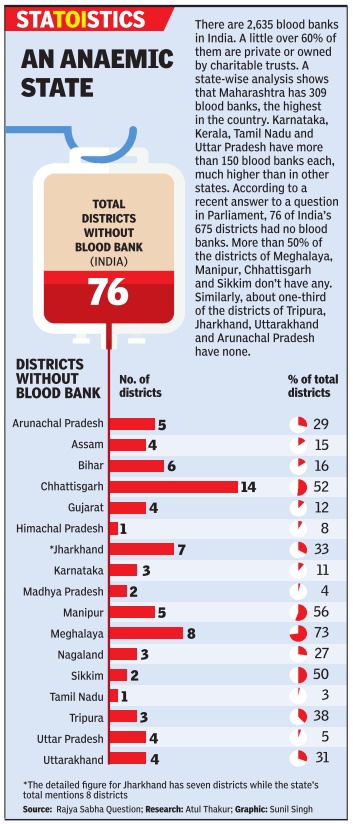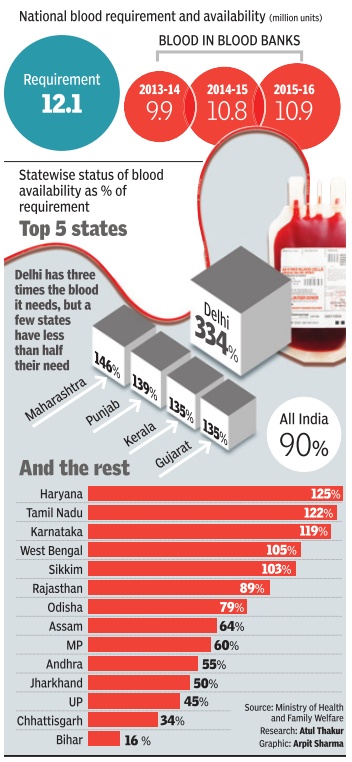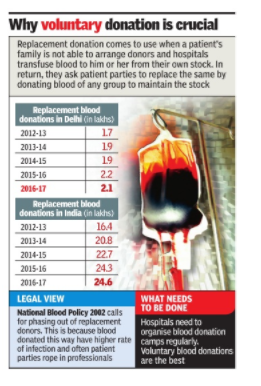Blood banks, donation: India

This is a collection of articles archived for the excellence of their content. |
Contents |
Blood donation: the year-wise position
Collection through replacement donors, 2012-17
City Collected 1M Units In 5 Years Via Replacement Donation An RTI document has revealed that Delhi hospitals collected nearly one million units of blood through replacement donations in the last five years. This is the third highest across all states. At 20.15 lakh, Uttar Pradesh has the highest rate of blood collection through replacement donors, a practice discouraged by National Blood Bank Policy 2002, followed by Karnataka (9.88 lakh).
Simply put, replacement donation refers to blood given by a relative or friend in lieu of blood transfused to a patient from the hospital stock. It is a common practice across public as well as private medical institutions.
Research shows replacement donations carry a higher risk of infection such as Hepatitis B and C and HIV among others as compared to voluntary donations. “Patients often arrange for professional donors if they cannot find someone from among family and friends. They conceal medical history , which makes it difficult to rule out infection,“ explained a doctor on the condition of anonymity .
The doctor added that tests to screen donated blood through Elisa third generation kit can fail if the infection has been contracted three months before donations.
Dr Vijay Kumar from the geriatric division of AIIMS said hospitals seek replacement donors because there is a scarcity of voluntary donors and hospitals have to maintain their stocks.
“There is an urgent need for registry of voluntary donors and giving them incentives. We must do away with this practice of replacement donations because it is fraught with higher risk of infection and causes avoidable stress to pati ent's family,“ Kumar said. Resident doctors at AIIMS, Kumar added, are creating a list of voluntary donors from among themselves to help the needy .
Delhi has 69 blood banks of which 34 are run by private hospitals, 11by Delhi government hospitals, nine by central government hospitals, eight by voluntary organisations and three by municipal corporations. There are four private blood banks.
The RTI filed by Chetan Kothari from Mumbai shows 1.66 lakh units of blood were collected through replacement donations in Delhi in 2012-13.In 2013-14, 2014-15, 2015-16 and 2016-17, the figures stood at 1.88, 1.94, 2.21 and 2.14 lakh units, respectively.
Dr Bharat Singh, who heads Delhi State Blood Transfusion Cell (DSBTC), said that replacement donations are higher in private hospitals as compared to government hospitals and blood banks. “DSBTC can only recommend or suggest hospitals to seek more blood through donation. We do not have staff or infrastructure to organise camps for voluntary donation,“ he said.
A study to find prevalence of Transfusion Transmitted Infections (TTIs) in voluntary and replacement donors by a Karnataka-based medical college in 2010 found that out of 9,599 blood donors, 58 (0.6%) were tested reactive for blood transmitted infection.
Out of these, 38 (65%) were replacement donors. The prevalence of HIV was 0.06% in total donors; more in replacement (four) as compared to voluntary (two donors). The prevalence of Hepatitis B in total donors was 0.34% (33 cases).
The prevalence of Hepatitis C was also found to be higher in replacement donors, the researchers stated in the study that was published in Indian Journal of Hematology and Blood Transfusion.
2013-16
See graphics, 'State-wise status...' and 'Blood donors, voluntary...'


Women patients
Getting blood donor for women patients tough
Males outnumber female patients when it comes to major surgeries in city’s prominent hospitals. At both Max and Rockland, the percentage of females who had undergone major surgeries was about 45. Orthopaedics was the only department at Max where female patients outnumbered males — apart from oncology where only three operations had taken place. In the other four, women comprised between 29.75 to 44.44% of the patients.
At Rockland, the only department with more female surgeries was again orthopaedics at 53%. At others, the percentage was about 42-43%.
Doctors say while families may not necessarily refuse point blank to go ahead with an expensive surgery when the patient is a woman, the sense of urgency is definitely less. As a result, many do not survive till the surgery. Getting simple things like a blood donor for a woman patient is almost always difficult as family members seldom volunteer, they say. As TOI had highlighted earlier, in case of organ transplants, while the male-female ratio is heavily skewed in favour of males when it comes to recipients, it is almost equally tilted in favour of females when it comes to donors.
The reaction of a family when a woman is advised an expensive surgery is to go ‘‘doctor-shopping’ in search of a less expensive or a non-surgical option, says Dr Akash Juneja, consultant ENT surgeon at Jaipur Golden Hospital. ‘‘They lose time. This seldom happens when the patient is a male. In India, the decision-maker is always the husband. So the surgery can wait. Man being the bread-winner is thought to ‘deserve’ quality care,’’ he says.
Says Dr Anupam Sibal, medical director, Indraprastha Apollo Hospitals: ‘‘Some 20-25% more women than men will not come back if advised an expensive surgery. Even if its a child, there will be many more questions asked before the surgery of the daughter, the commonest being whether marrying her off may be a problem because of the surgery.’’ He adds, ‘‘Women in our country are always somewhat neglected — look at nutrition, they are always the last to eat in the family. Their health is often rock bottom in the family’s priority list so that they suffer in pain.”
